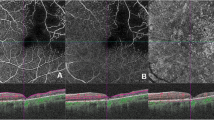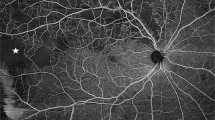Abstract
Purpose
To compare the imaging of retinal vein occlusion (RVO) with optical coherence tomography angiography (OCTA) and fluorescein angiography (FA) and evaluate their roles in clinical management.
Methods
RVO patients who underwent imaging with both FA and OCTA from 1 June 2015–31 December 2015 were enrolled. An independent retinal specialist blinded from patient identity assessed the FA and OCTA reports. The pixel counting technique was used for FAZ size measurement. A significant level of p < 0.05 was taken for correlation and agreement analysis.
Results
On OCTA, the mean FAZ size was 0.382 ± 0.152 mm2 and 0.606 ± 0.136 mm2 for the superficial and deep retinal layers, respectively, with significant correlation (p = 0.004). On FA, the mean FAZ size was 0.352 ± 0.158 mm2, better correlated with OCTA at the superficial (p = 0.062) than the deep retinal layer (p = 0.122). Between FA and OCTA, good agreement was found for microaneurysms (100%, p = 0.001) and venous congestion (83.33%, p = 0.028), but not capillary non-perfusion (p = 0.217) and venous tortuosity (p = 0.546). OCTA also revealed more capillary non-perfusion than FA (91.67 vs. 58.33%). The presenting best-corrected visual acuity was significantly correlated with capillary non-perfusion on OCTA (p = 0.001).
Conclusion
OCTA and FA are complementary tools in RVO assessment. While OCTA is more precise in the assessment of FAZ and capillary non-perfusion, FA offers better vascular imaging of the peripheral retina.



Similar content being viewed by others
References
Mitchell P, Smith W, Chang A (1996) Prevalence and associations of retinal vein occlusion in Australia. The Blue Mountains Eye Study. Arch Ophthalmol 114:1243–1247
Klein R et al (2000) The epidemiology of retinal vein occlusion: the Beaver Dam Eye Study. Trans Am Ophthalmol Soc 98:133–141 (discussion 141-33)
The Central Vein Occlusion Study Group (1997) Natural history and clinical management of central retinal vein occlusion. Arch Ophthalmol 115:486–491
Ho M, Liu DT, Lam DS, Jonas JB (2016) Retinal vein occlusions from basics to the latest treatment. Retina 36:432–448
Yannuzzi LA, Rohrer KT, Tindel LJ, Sobel RS, Costanza MA, Shields W, Zang E (1986) Fluorescein angiography complication survey. Ophthalmology 93(5):611–617
Jia Y, Bailey ST, Hwang TS et al (2015) Quantitative optical coherence tomography angiography of vascular abnormalities in the living human eye. Proc Natl Acad Sci USA 112(18):E2395–E2402
Suzuki N, Hirano Y, Yoshida M, Tomiyasu T, Uemura A, Yasukawa T, Ogura Y (2016) Microvascular abnormalities on optical coherence tomography angiography in macular edema associated with branch retinal vein occlusion. Am J Ophthalol 161:126–132
Rispoli M, Savastano MC, Lumbroso B (2015) Capillary network anomalies in branch retinal vein occlusion on optical coherence tomography. Retina 35:2332–2338
Samara WA, Say EAT, Khoo CTL, Higgins TP, Magrath G, Freenczy S, Shields CL (2015) Correlation of foveal avascular zone size with foveal morphology in normal eyes using optical coherence tomography angiography. Retina 35:2188–2195
John D, Kuriakose T, Devasahayam S, Braganza A (2011) Dimensions of the foveal avascular zone using the Heidelberg retinal angiogram-2 in normal eyes. Indian J Ophthalmol 59(1):9–11
Coscas F, Glacet-Bernard A, Miere A et al (2016) Optical coherence tomography angiography in retinal vein occlusion: evaluation of superficial and deep capillary plexa. Am J Ophthalmol 161:160–171
Jia Y, Wei E, Wang X, Zhang X, Morrison JC, Parikh M et al (2014) Optical coherence tomograph angiography of optic disc perfusion in glaucoma. Ophthalmology 121:1322–1332
Spaide RF, Klancnik JM Jr, Cooney MJ (2015) Retinal vascular layers imaged by fluorescein angiography and optical coherence tomography angiography. JAMA Ophthalmol 133(1):45–50
Carlo TE, Salz DA, Waheed NK, Baumal CR, Duker JS, Witkin AJ (2015) Visualization of the retinal vasculature using wide-field montage optical coherence tomography angiography. Ophthalmic Surg Lasers Imaging Retina 46:611–616
Cardoso JN, Keane PA, Sim DA, Bradley P, Agrawal R, Addison PK, Egan C, Tufail A (2016) Systemic evaluation of optical coherence tomography angiography in retinal vein occlusion. Am J Ophthalmol 163:93–107
The Central Vein Occlusion Study Group (1995) A randomized clinical trial of early panretinal photocoagulation for ischemic central vein occlusion. The Central Vein Occlusion Study Group N Report. Ophthalmology 102:1434–1444
The Branch Vein Occlusion Study Group (1984) Argon laser photocoagulation for macular edema in branch vein occlusion. Am J Ophthalmol 98:271–282
Author information
Authors and Affiliations
Corresponding author
Ethics declarations
Conflict of interest
The authors declare that they have no conflict of interest and no financial disclosure.
Human and animal rights
This article does not contain any studies with human participants or animals performed by any of the authors.
Informed consent
For this type of study, formal consent is not required.
Rights and permissions
About this article
Cite this article
Chung, C.Y., Tang, H.H.Y., Li, S.H. et al. Differential microvascular assessment of retinal vein occlusion with coherence tomography angiography and fluorescein angiography: a blinded comparative study. Int Ophthalmol 38, 1119–1128 (2018). https://doi.org/10.1007/s10792-017-0570-y
Received:
Accepted:
Published:
Issue Date:
DOI: https://doi.org/10.1007/s10792-017-0570-y




